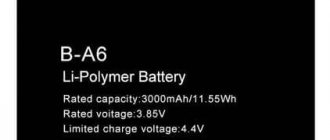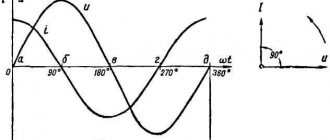A car battery consists of 6 cells connected in series. Each bank has a full charge of 2.10-2.15 V, so the total voltage is summed up and is 12.6 - 12.8 V. What is the voltage of the battery after the charger is turned off? When installing the battery in a car, the voltage after charging should be 12.4 V. This is normal. The car's starter battery is discharged during engine startup and, while driving, it recovers energy from the car's generator. If the battery voltage drops to 12 V, the device requires charging from the network. A large loss of charge in banks is characterized as a deep discharge that destroys the battery.
We charge the battery with direct current
With this approach, the constant electrical parameter becomes the current strength - I. It is recommended to set it at 10% of the total battery capacity. For example, if the maximum battery life is 65 A*h, then it should be charged with a constant current of 6.5 A. It is clear that the voltage will change.
Signs of a charged battery:
- Electrolyte gas is intensely released.
- The current and voltage values remain unchanged for an hour or more.
When the voltage reaches 14.4 V, the current must be halved. When it reaches 15 V, it doubles again. And this should be done until the tension becomes constant. For an additional (insurance) calculation, you can also use a special online calculator.
We charge the battery with constant voltage
With this approach, the constant electrical parameter becomes the current voltage - U. It is set at a level that depends on the degree of discharge of the battery. The current strength at the moment the charging is connected will be maximum. As the battery life is replenished, it decreases exponentially. The constant voltage value determines the battery charging speed. During the day, on average, the battery is charged by:
- 80-85% at U = 14.4 V.
- 85-90% at U = 15 V.
- 95-98% at U = 16 V.
- 98-100% at U = 16.4 V.
Some manufacturers limit the maximum allowable voltage. Most often it is set at 14.4 V. At this constant voltage, charging time is more than 24 hours.
Under load
To find out the battery voltage, you need to purchase a special device. However, it only allows you to find out the readiness of the battery for further operation and the state of charge of the battery. This product is not suitable for determining energy content. For this reason, there is no way to determine the battery life through this product.
The device has the following equipment, which includes:
- housing with a built-in device, a multimeter;
- spirals that provide resistance;
- cables that have “crocodiles” at the ends for easy connection to the battery;
- switch.
There are 2 types of such products: digital, which show the parameter on the display, and analog, which shows the value using an arrow. The first type is better because it produces a more accurate value compared to the second. Most load forks operate at positive temperatures from 1˚С to 35˚С. But there are products that can work well even at -25˚С, but the cost of such a device will be many times higher than conventional devices. The product can generate current from 100A to 200A.
A battery test using a load fork can be performed within 10 seconds, although according to harmonized standards the test can be performed for 20 seconds.
When to charge the battery
Charging is only necessary if the battery is truly discharged. There are different ways to check a resource:
- Voltage measurement at the terminals. A voltmeter, multimeter or pointer tester will do. The standard value is 12-12.7 V. If the actual value is more than 12.5 V, the battery is charged, 12-12.5 V is half charged, less than 12 V is discharged.
- Electrolyte density measurement. The method is only relevant for serviced batteries. You can measure the density with a hydrometer. If the value is around 1.27 g/cm3, no charging is required; noticeably less is required.
- Problems starting the engine. The starter does not turn, the audio system “stutters” or is quiet, dim lighting are sure signs that the battery is low.
It is highly not recommended to use a depleted battery. Due to the chemical reactions that occur, its durability is significantly reduced.
All verification methods
There are different ways to check the voltage of a car battery for its level of discharge. Let's look at them.
Multimeter
To check Akum, Vatra and other brands of batteries installed on KamAZ, Volvo, and BMW vehicles, it is convenient to use a multimeter.
Automotive multimeter
You will find the device in any specialized store; it is available at service stations. For one-time measurements, it’s easier to borrow a multimeter, although most drivers need it regularly.
Digital devices are more expensive than mechanical ones, but they are more convenient to use.
Most likely, the readings of the multimeter and the on-board computer will differ.
Standard dashboard devices often make mistakes and give an insignificant error, since they are not directly connected to the battery. Usually the deviations are on the smaller side.
With the engine running
We have figured out what voltage should be on a charged car battery, now we will consider the procedure for measuring current indicators with the engine running.
The main working tool is a multimeter.
First, take measurements with the engine running - normally the value should be around 13.5–14.0 volts.
If the value is greater than 14.2 volts, the charge is low, the generator will direct energy to charge the battery. Excessive indicators in the winter season are considered the norm in this case.
There is nothing wrong with high current. When everything is in order with the electrical equipment, after 10 minutes the electronic parts of the system will drop the current values to the standard maximum 14 volts.
In the absence of this reaction, the figure is not gradually reset to optimal values, and the battery may be overcharged. It will constantly function at maximum efficiency and the electrolyte will begin to boil away.
When the indicator is less than 13.0–13.4 volts when the engine is turned on, we can talk about the lack of full charge. Do not immediately run to the service center; first, measure the readings with the consumers turned off - this is the air conditioner, radio, headlights, cigarette lighter, etc.
A sharp drop is also possible if the contacts are oxidized - check them before going to the service center and, if necessary, clean them with sandpaper.
Another method of checking is with the power consumption sources turned off and the engine running, you should get 13.6. Check the parameters for compliance, if everything is normal, turn on the low beam, and the indicator should drop by 0.1–0.2 volts.
Now turn on music, split-system, and other energy consumers in the car. Perform the actions gradually, each time you turn on the consumer again, the parameter should drop slightly.
If there are sudden surges, most likely the problem is in the generator system - it is not working at full power, or the brushes are worn out or dirty.
Even if all energy consumers are turned on, the indicator still does not normally fall below 13 V. Otherwise, the battery will begin to discharge heavily and will run out completely.
The solution to the problem in this case is to replace the battery.
With the motor off
You will also need a multimeter to carry out the work. If the reading on the terminals is below 11.8 volts, the car most likely simply will not start; you will have to light it from another car.
The normal level with the engine turned off is 12.5–13.0 volts. A value of 12.9 indicates that the battery is approximately 90% charged, 12.5 - half charged, 12.1 - no more than 10% remaining. These are calculations by eye, but many motorists use them.
An important nuance of checking with the engine turned off is that if the engine has just been turned off, the value will be one, but the morning after it has been idle it will be different.
It is optimal to measure the voltage immediately before the trip. The battery charge level indicates its ability to hold values for several days. If the battery is fully charged and you have not driven for a week or more, the parameter will drop sharply. That is, the value is not constant.
Using a load fork
Testing the battery using a load fork is an accurate, simple and effective way to check the performance of a car battery. Eventually you will find out if the battery is charged.
Connect the plug to the correct battery terminal for a maximum of 5 seconds. At first it should be around 12–13 volts, after the fifth second it should be more than 10 volts, despite the decrease. Such a battery is considered fully charged and can operate under different loads.
When the indicator during testing when checking with a load plug drops to 9 volts, the battery is faulty, and it is recommended to replace it.
During the cold season
A decrease in the temperature of the environment causes changes in the nominal density of the working substance - the electrolyte. Taking into account the battery charge level, the reaction to low temperatures will be determined.
A fully charged battery will have a sharp increase in density, which will cause a sharp jump in measurements.
When the power supply is dead, the density decreases due to frost, and difficulties arise when starting the engine.
Drivers completely mistakenly believe that in winter the battery is further discharged due to low air temperatures. In reality, the role is played not by the low temperature of the environment, but by the slowdown of chemical processes in the battery as a result of frost.
How to charge a calcium battery
Batteries of this type are practically maintenance-free. They have a solid capacity and high starting currents, but if they are not charged correctly, their service life rapidly decreases with each cycle. Calcium batteries (Ca-Ca) must be charged with direct current with a voltage of 16-16.5 V. If the value is less, then it will not be possible to replenish the energy resource to 100%.
The generators of most cars rarely produce voltage above 15 V. Therefore, calcium batteries should be recharged monthly with special programmable chargers. Charging process:
- Set the charger amperage to about 10% of the battery's rated capacity.
- Set the voltage value on the charger in the range of 16.1-16.5 V.
- Set two modes: upper – U = 16.1 V, I = 3 A; lower – U = 13.2 V, I = 0 A.
As the battery charges, the voltage and current will vary within the specified range. This happens cyclically, with a wave-like rise/fall of U/I. That is why it is recommended to charge calcium batteries only with programmable chargers.
Can I “light up” from another car?
Charging a car battery with a charger is not always available. In this case, another battery will be useful, which will be a kind of “donor”. This is quite simple to do: you just need to connect the same terminals of the two devices using wires with alligator clips and turn on the motors. This is what most motorists do. This, of course, is a way out of a difficult situation, but often such “lighting up” ends in the failure of the electrical equipment of the car, because this is a completely wrong approach.
To properly replenish the battery charge in the cold, you must:
1. Turn on the engine and warm it up for 5 minutes.
2. Turn off the engine. Remove the terminal from the negative terminal, connect the cigarette lighter wires to the positive and negative terminals of the battery.
3. After this, you can connect to the donor. Turn on the engine, after a few minutes, without turning it off, disconnect the wires for “lighting up”.
To recharge the battery after this, you should drive in a low gear, the engine speed should be approximately 3000 rpm. In this mode, the generator will provide sufficient current to both charge the battery and operate the vehicle's electrical equipment.
How to charge a gel battery
This type of battery is one of the most common. Gel batteries are used in cars, motorcycles, ATVs, uninterruptible power systems, etc. They are characterized by high current output, multi-charge capability, and minimal self-discharge current. However, it is unacceptable to recharge them, because this can lead to a reduction in the total capacity resource.
Principles of charging gel batteries:
- Use a charger with a voltage and current regulator.
- When charging, set the current at 10-30% of the rated capacity.
- The maximum voltage value is 14.5-15 V.
The electrolyte in this type of battery is gel. It melts if the voltage is exceeded or the charging time is excessive. That is why it is recommended to use electronic chargers that automatically select the optimal current parameters, taking into account the specifics, condition and characteristics of the battery.
How to charge a hybrid battery
Batteries of this type combine antimony and calcium plates. They are resistant to deep discharge and produce high inrush current. Moreover, their cost is noticeably lower than calcium analogues, not to mention gel ones. Such batteries are low maintenance. But they have traffic jams. Therefore, once a quarter it is necessary to check the electrolyte level and replenish the reservoir with distilled water if necessary.
Charging principles:
- Set the current value within 10-30% of the rated capacity.
- Keep the voltage in the range of 13.8-14.2 V.
- When U = 14.2 V and I = 0.3-0.5 A, the battery is fully charged.
Due to the high operating voltage, the electrolyte heats up. In winter, this makes starting the engine easier. However, in summer the electrolyte evaporates. And therefore it needs to be refilled regularly. Otherwise, the exposed plates may melt and fail completely or partially.
Safety rules when charging a car battery at home
It is permissible to charge a car battery only if all safety rules are strictly observed. Charging time can be up to 10, depending on the specific device and the battery itself. In most cases they are rated at 60 amps, but there are models that deviate from the standard.
The room must be ventilated and there should be no proximity to fire or sparks. In this case, charging should be constantly monitored. During connection, the plugs are unscrewed.
It is much better to initially protect yourself and use another room to charge the battery. This could be a garage, or you should contact a professional car service, where the entire process will be carefully monitored and will ensure careful and complete charging. If such options are not considered, then you should take into account the safety rules and follow them without any discrepancies. Otherwise, there may be an accumulation of gases from the electrolyte, an explosion as a result of an accidental spark, or the process will not have any result at all and you will have to turn to professionals for charging.
How to charge an AGM battery
Batteries of this type are a new trend in the world of batteries. They have high starting currents (up to 900 A) and are quickly charged, including from a generator. And they last 3-5 years longer than acid analogues. You can charge them in three ways:
- Charge, accumulation, storage. If the battery is used, then when replenishing the energy resource, it is necessary to set the voltage to 14.2-14.8 V, the current strength to be within 10-30% of the nominal capacity. When storing in a garage or warehouse, the values should be maintained at the following levels: U = 13.2-13.8 V, and I = 5-10% of the nominal value.
- Charging and storage. The battery life should be replenished at a voltage of 14.2-14.8 V, current strength - 10-30% of the nominal capacity. During storage, it is necessary to maintain the voltage at 13.2-13.8 V.
- Charge. Some manufacturers do not indicate parameters for storing batteries. But for charging them, the same standards are recommended: U = 14.2-14.8 V, I = 10-30% of the nominal value.
When replenishing energy resources, you need to closely monitor the voltage and current. Therefore, it is recommended to use electronic dual-mode chargers for charging.
Engine running
When the car engine is running for more than 10 minutes, the voltage will be from 13.5V to 14.5V. In this case, the parameter will be slightly larger than usual, since the car generator is running. It is necessary to start checking the voltage value after the engine has been running for more than 20 minutes. Then you need to turn on the elements that consume vehicle energy:
- glass cleaners;
- windshield heater;
- stove;
- high beam;
- car radio
After this, the value should change slightly (by about 0.2V). If the value has decreased significantly, then most likely your generator is in a faulty state or there is another situation, for example, if you are using a subwoofer or other powerful device, and the generator cannot cope with such a load, for this reason the voltage begins to sag. In this case, there is only one solution - buy a more powerful generator.











